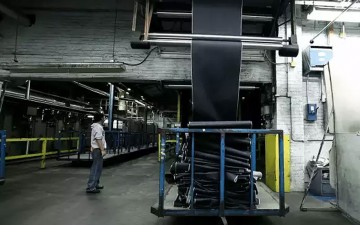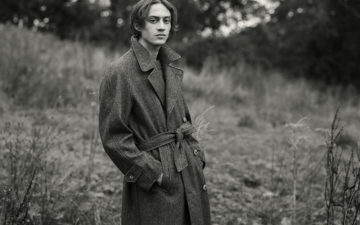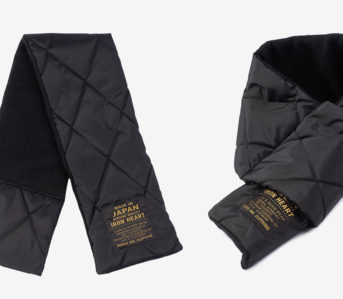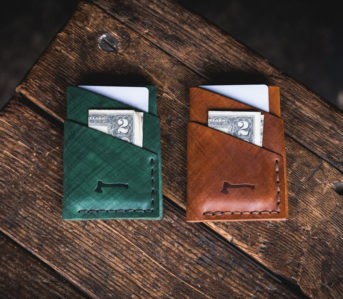Of the outdoor clothing companies in American History, there is one that has been around longer and has innovated more than most, yet is largely absent from the conversation among enthusiasts today, Eddie Bauer.
So what happened? Why hasn’t Eddie Bauer, the maker that outfitted the first American expedition to Mount Everest, stood the test of time the way its vintage pieces have? Today we’re going to be diving into the man, the products, and the brand that bear the Eddie Bauer name.
Eddie’s Origins
A young Eddie Bauer via Sporting Classic Daily
Eddie Bauer was started in 1920 by the man of the same name. And although I say man, maybe late teen is more appropriate by today’s standards. He was barely 21 years old when he rented space in a local hunting and fishing shop in downtown Seattle and opened a tennis repair business. Needing only a workbench, Eddie specialized in building and repairing tennis rackets. But this was only the beginning.
Off the court, Bauer was also immersed in the great outdoors from the start. He was born in Eastsound, Washington, on Orcas Island in 1899 as the son of German immigrant parents. His early bond with nature would never leave him and go on to inform the design and direction of his company.
By 13, he dropped out of school to work at Seattle’s Piper & Taft, one of the largest sporting goods retailers on the West Coast. This was basically an apprenticeship which would level up his hunting and fishing skills and give him the confidence to go into business at such a young age.
Bauer would eventually expand his niche operation into somehow more niche sounding offerings under the name Eddie Bauer’s Sports Shop, with hand-made golf clubs, fishing tackle, and even developed and patented the standardized badminton shuttlecock that is still used today (that last fact alone deserves its own article, maybe on our sister site Shuddels).
In the late 1920s, EB’s Sport Shop picked up steam while competing in clay pigeon shooting contests. Bauer and his wife would compete while decked out in Bauer clothing, serving as a walking billboards for the company. It didn’t hurt that they’d go on to win several state championship titles together.
Bauer wearing a sweater fitted with felt embroidery advertising his company
Bauer’s first big break into the big leagues of Seattle based outdoors outfitters came after a brush with death. While returning to his vehicle after a fishing trip in the Olympic Peninsula on a freezing day in January of 1935, Bauer fell behind his friend and felt himself getting sleepy–an early sign of hypothermia.
Still wet from fishing, sweating from lugging all the fish, and soaked from rain and snow beating down on him, he began to freeze. Like ice cube freeze. Luckily he had a gun with him (I’ve been fishing wrong all these years) and managed to fire a few signal shots in the air to alert his speed walking friend something was up right before nodding off against a tree.
Connecting this near death experience to an inadequate top layer, likely a wool mackinaw, Bauer sought to create a lighter, more weather tolerant jacket for outdoorsmen. Channeling the descriptions of down filled clothing his uncle described wearing as a soldier in the Russo-Japanese War to fight off the Manchurian winters, he got to work.
By 1940, Bauer had patented the first quilted goose down-insulated jacket in the United States, known as the Skyliner. Like Levi’s and the copper rivet, Bauer held the exclusive right to use a quilted diamond pattern for 14 years, during that time he expanded to 20 other designs.
An early Skyliner via Gear Patrol
A vintage Skyliner advertisement via Pinterest
Bauer’s next big break came during WWII as the United States Air Corp commissioned him to make the first insulated flight jacket. His design would be known as the B-9 Flight Parka. In total more than 50,000 of Bauer’s parkas were produced for airmen during the war.
In addition to the B-9s, the company also made pants, backpacks, and sleeping bags for the troops. Continuing with the tradition of firsts, Bauer somehow managed to get permission to affix his company logo to all this military gear, the only government supplier to get this chance during the war.
USAAF pilot wearing a B-9 Parka via Tread Magazine
When GIs returned home and reflected on the pieces that kept them alive, all they had to do was look for the Eddie Bauer tag and thus the postwar demand began. When he launched his first mail-order catalog in 1945, the mailing list included the names of 14,000 soldiers who had worn Eddie Bauer clothing during the war.
By the late 1940s, Bauer closed his downtown store in Seattle and besides a small showroom in his factory, got out of retail. By this point in the game, Bauer employed 125 seamstresses.
In 1950, as Bauer’s health declined due to overwork and a serious back injury, he brought William F. Niemi, a hunting partner and local businessmen, into the fold, eventually forming a 50-50 partnership in 1953. Niemi’s impact included improving cashflow and other logistics less related to EB’s product offerings. The 50s also marked a new type of clientele for the retailer: scientists and high stakes explorers.
As frontiersmen were exploring the boundaries of nature, they were wearing Eddie Bauer. This included several Antarctic explorations, the American K2 Himalayan Expedition, and James Whittaker’s Mount Everest climb in 1963. Whittaker was the first American to reach the summit and he did it in head to toe Bauer. The most memorable piece from this historical adventure being the aptly named Mt. Everest Parka. By 1968, having impacted the outdoor apparel world for several lifetimes, Bauer and his son sold their remaining half of the company to William Niemi and his son for $1.5 million (about $11.2 million in 2021).
James Whittaker making the MT Everest Parka on location via Gear Junkie
50 years after Eddie first launched his tennis repair shop, the first large Eddie Bauer store opened in downtown Seattle in 1970. This was also when the focus of the brand began to shift. Although known for being an outdoor clothing retailer with decades of wear and tear experience, Niemi shifted the focus to casual lifestyle apparel (a few decades ahead of Patagonia and The North Face).
In 1971, Niemi senior sold the company to General Mills—yes the company of Cinnamon Toast Crunch, Lucky Charms, and Fiber One fame. But it actually went well on paper for a while, expanding to 61 stores and making $250 million in sales by 1988. But you know that change of direction that I was talking about earlier? Yeah General Mills really went off. The dropped the company’s tag line “Expedition Outfitter” and by 1984 you could buy a Eddie Bauer Ford Bronco.
1984 Eddie Bauer Bronco via Barn Finds
In 1988, the cereal tycoon sold Eddie to Spiegel which immediately hit the ground running, expanding to 99 stores and up to 300 by 1996. Amidst this ramp up, in 1991, Spiegel launched Eddie Bauer Home, a collection of home furnishings including furniture, tableware, and décor items. This is really where the issues become apparent to me. The company known for revolutionizing outdoors clothing turned everyday casual clothing turned Ford collaborator was now in the dining room table game. By 1998 over 500 domestic stores had been opened, 32 locations in Japan and 9 locations in Germany.
2005 brought Spiegel into bankruptcy, selling all its assets, except for their crown jewel, guess who, which emerged as Spiegel’s stand-alone venture in May of the same year. In 2011, it again filed for bankruptcy and Eddie Bauer was purchased by Golden Gate Capital. In 2018, it merged with other mall retailer Pac Sun, also owned by Gold Gate. And thus we have the final transformation of the legendary outfitter to mall mainstay.
Iconic Jackets
The Skyliner
Warehouse & Co Lot. 2144 Down Jacket Beige via Clutch Cafe
Credited as being the first quilted goose down insulated jacket in the United States it’s really on the same level as putting rivets on pants or making sweatshirts out of cotton instead of wool – that’s how iconic and revolutionary this innovation was. And yet you know the name Levi’s and Russell but not our old pal Eddie Bauer?
Fortunately Warehouse Japan is keeping the dream alive with their repro, which if you know anything about the brand, you will see to be a painstakingly exact replica down to the design of the tag.
Available for $1100 at Clutch Cafe.
The Kara Koram Parka and Pants
Frizmworks X All Blues Co Karakoram Parka – Orange
Developed for the third American Karakoram Expedition, the Karakoram Parka and Pants featured a rip-stop nylon shell and Bauer’s patented quilted design and met the needs of the mountaineers and the weekend warriors that came after. The parka basically hit the peak of what a winter outdoors jacket should be. Good puff, zipper with buttons on top, and adjustable waist and hem strings to keep everything tight. The full package.
So whether you wanted to go full Michelin Man or just wanted part of the get up to help you survive the winter, All Blues Co and The Real McCoys have you covered with faithful reproductions.
Available for 299GBP (~$409USD) at All Blues Co.
The Mount Everest Parka
Original Everest Parka via Gear Junkie
Officially called the Style #088, MT. Everest Parka, the Everest Parka was the weapon of choice for mountaineer Jim Whittaker as he became the first American to reach the summit of the world’s tallest peak in 1963. Filled with 100% northern goose down, the insulated jacket could withstand -85 degree Fahrenheit temps.
Its bright red outer layer was made of ripstop nylon, with this fancy new thing called Velcro stitched on the pocket flaps, and the hood was lined with wolverine fur. Around 50 were produced for the historic expedition. And although there are tons of ‘puffy’ jackets out there today, I think the reason this model has never been properly repro’d (to my knowledge) is because it was built not necessarily like clothing but armor that could withstand certain tests, so unless the repro could do the same, what’s the point?
Eddie Bauer Today
Recently celebrating its one hundredth year of business, the brand has honed in their vision after their diversification tear of the past decade. This will be key going forward because in the rough patches that the company endured each time it changed hands, the identity of the company weakened, which doesn’t create a mountainload of trust in consumers.
So to crush the doubts that the brand is only riding on the coattails of its past legacy, it has to prove its still making strides in the arena it all started: The great outdoors. And it has. Their site boasts at least 10 products which have all received critical acclaim recently, including the EverTherm Down Jacket, BC Freshline Jacket & Bib, and the Flying Squirrel 40 Degree Sleeping Bag which have racked up a combined 12 awards in the last few years.
Screenshot via Eddie Bauer
For the future of the brand, what would I like to see? Reissuing some of their classic pieces in a heritage collection would be a great way to educate and immerse generations of people into the early stages of the outerwear pioneer. I couldn’t cover everything about this company’s long and fascinating history which is a testament to its richness. But just by taking a glimpse at it, especially of the early days, has made me want to be a part of it. And isn’t that what a strong brand is all about?




